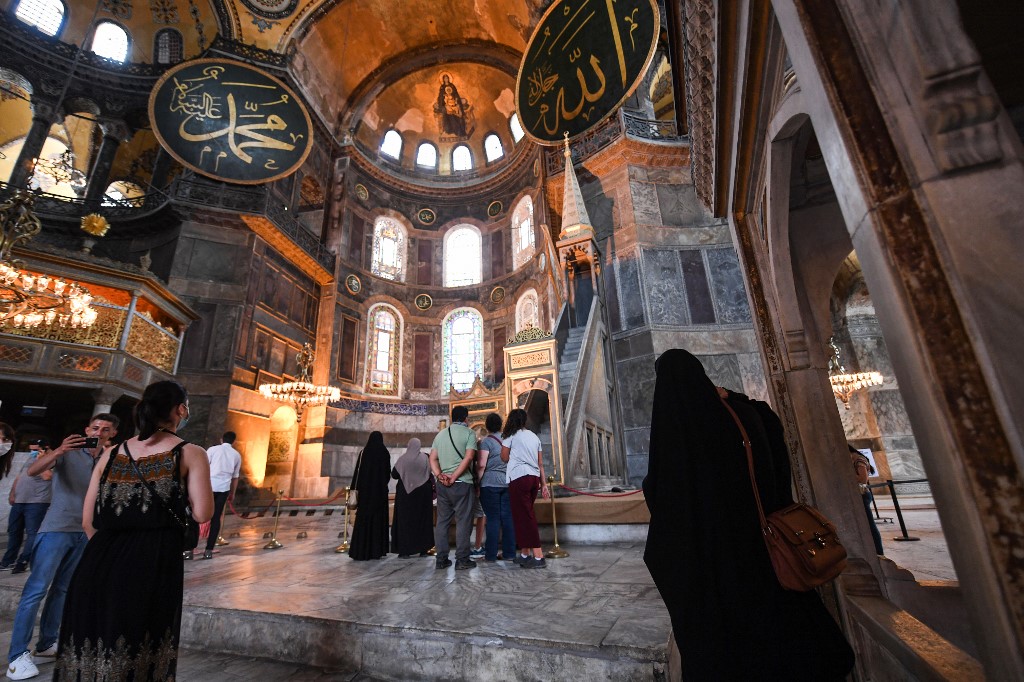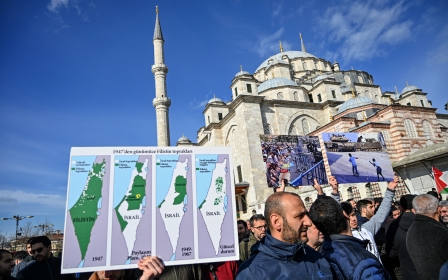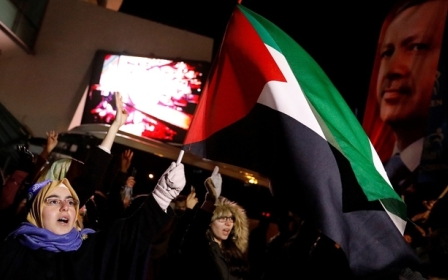Was Erdogan right to declare the Hagia Sophia a mosque?
When Mehmed II prayed in the Hagia Sophia after the conquest of Constantinople on 29 May 1453, it signalled a turning point in the power balance in Anatolia in favour of a young new force, the Muslim Turks, who had emerged from Central Asia.
Five centuries later, on 1 February 1935, when Kemal Ataturk declared the Hagia Sophia a museum, it was another turning point, announcing the age of Kemalism - of top-down, forced westernisation and secularisation.
The Hagia Sophia’s enormous, precious prayer carpet was torn to pieces. Its school annex, the first Ottoman university, was demolished. The gigantic candles that lit its prayer halls were chopped off and melted. Its small Beyazit II minaret was destroyed and the rest of its minarets were due to follow suit, had it not turned out that they supported the domes, which would then have collapsed, bringing the whole edifice down.
The project of Kemalism
The conversion was a resounding declaration of the project of Kemalism, which placed the elimination of Turkey’s religious heritage at the forefront. The replacement of the Ottoman Arabic script with the Latin alphabet, the ban on the call to prayer in the original Arabic, prohibition of traditional Islamic dress, and closure of hundreds of mosques, schools, shrines and religious endowments, were other manifestations of this radical project.
The Turks saw Ataturk as a great liberator, a national hero who had confronted British and French forces as they occupied Anatolia - so much so that he was known as “Gazi Kemal”, or Conqueror; a new Mehmed II, no less.
The message was clear and unequivocal: there will be no tolerance of religious expression in whatever shape or form - not even simple, mundane rituals and practices
Ataturk proceeded to use the legitimacy acquired from his role in the national liberation struggle to launch a virulent campaign against the country’s Ottoman legacy, in favour of a state-imposed modernisation and military secularisation, which revolved around his cult of personality.
When three decades later, elected Prime Minister, Adnan Menderes, though neither religious nor an Islamist, sought to reign in this ferocious assault on society’s culture and identity, for instance, by reinstating the call to prayer (Adhan) in Arabic, which had been raised exclusively in Turkish for 18 years, he was toppled by a brutal military coup, imprisoned and taken to the gallows on 17 September 1961.
The message was clear and unequivocal: there will be no tolerance of religious expression in whatever shape or form - not even simple, mundane rituals and practices.
Charting a different path
Much water has flown under Istanbul’s bridges since then. Secularism’s sacred military guards found themselves face to face with a movement of Islamisation, which sprung from the depths of Turkish society, from mosques and shrines, schools and universities.
In the 1970s and ‘80s, this vast, fast-growing grassroots movement came to assume a soft political character, which grew increasingly vocal. The young Recep Tayyip Erdogan had himself been part of this rising movement before he was elected mayor of a decaying Istanbul and began to chart a different path from that of his teacher, Necmettin Erbakan.
Erdogan’s recent decision to return the Hagia Sophia to its former status as a place of worship has, in fact, little to do with a conflict between Islam and Christianity, or church and mosque. It forms part of the journey that has been unfolding in Turkey over the last four decades: a rejection of military secularisation and forced, top-down westernisation.
Erdogan has been seeking to renew his country’s links with its past Ottoman Islamic history, and to reclaim its symbols and legitimacy, at the heart of which lies the Hagia Sophia.
Sifting through Erdogan’s public statements and discourses since before he was Istanbul’s mayor, one cannot fail to note the frequent references to the Hagia Sophia. Though he often expressed reluctance to change the status of the iconic monument, fearing that the moment was not right, references to Hagia Sophia can be found in his discourse since before he was Istanbul mayor.
His imprisonment in 1999 followed a public speech in which he had passionately quoted the famous verses of nationalist Turkish poet Ziya Gokalp: "The minarets are our spears, the domes our helmets, mosques our barracks, the faithful our soldiers."
Reclaiming the Ottoman past
Just as declaring the Hagia Sophia a museum symbolised a rupture with Turkey’s Ottoman past and an affirmation of the rise of western secularisation, its reinstatement as a mosque signifies a reclaiming of the country’s past. Erdogan describes it as a return to our forefathers; a return to the past as a launching pad to the future, to a new Turkey reconciled with its Ottoman past.
It comes as a conflict of legitimacy rages around the region among different heavyweights. In Saudi Arabia, the de facto ruler, Crown Prince Mohammed bin Salman, has been moving from a state-imposed Wahhabism to an aggressive model of state-imposed westernisation, in sharp contrast with the country’s status as the custodian of Mecca and Medina.
In Egypt next door, al-Azhar, once a powerful centre of Sunni Islam, has lost all influence and credibility. Its sheiks are now seen as little more than officials appointed by military intelligence to legitimise President Abdel Fattah el-Sisi’s policies.
The virulent hostility towards political Islam shared by the two countries (along with the UAE) has driven them to antagonism towards Islam itself.
Turkey, meanwhile, has been going in the opposite direction: affirming its credentials as a leader of Sunni Islam and investing in its symbolic capital as the heir to the Ottoman Empire.
An inspiring model
Though the reinstatement of the Hagia Sophia as a mosque is a domestic Turkish affair, it has resonated throughout the Muslim world. Erdogan has been hailed by his supporters as a powerful Muslim leader - the antidote to weak Arab kings and presidents who are seen as complicit in much Muslim suffering, turning their backs on Palestine, Islam and all that is sacred to their people, in order to preserve their corrupt, despotic reigns.
In their eyes, this was just another embodiment of western hypocrisy and double standards
After the Hagia Sophia decision, many Muslims commented that those outraged by the move had been undisturbed by the annexation of mosques big and small, by the conversion of mosques into cathedrals, or by the destruction and seizure of hundreds of other Islamic monuments in Spain, the Balkans, Palestine, Italy, India, Russia, or other parts of the world. In their eyes, this was just another embodiment of western hypocrisy and double standards.
For all the attacks against him in western and Arab media, Erdogan seems to have won the legitimacy contest.
The views expressed in this article belong to the author and do not necessarily reflect the editorial policy of Middle East Eye.
This article is available in French on Middle East Eye French edition.
Middle East Eye propose une couverture et une analyse indépendantes et incomparables du Moyen-Orient, de l’Afrique du Nord et d’autres régions du monde. Pour en savoir plus sur la reprise de ce contenu et les frais qui s’appliquent, veuillez remplir ce formulaire [en anglais]. Pour en savoir plus sur MEE, cliquez ici [en anglais].







